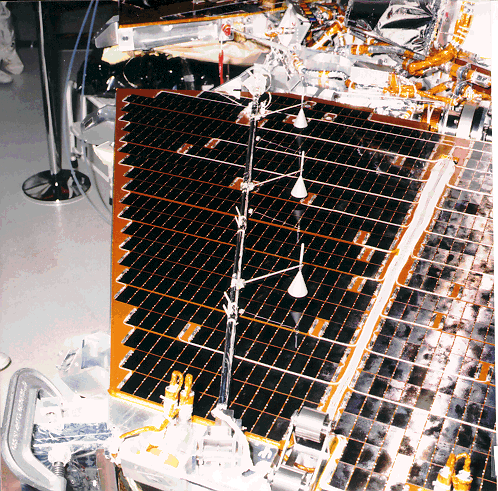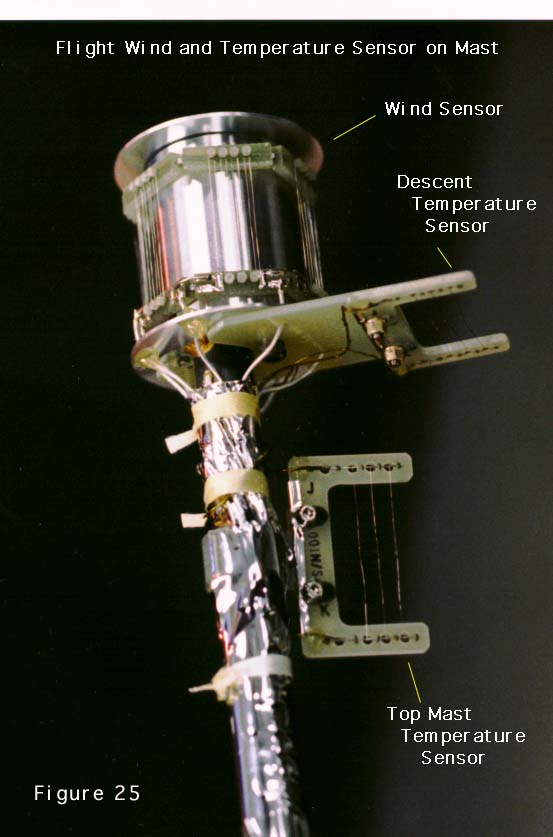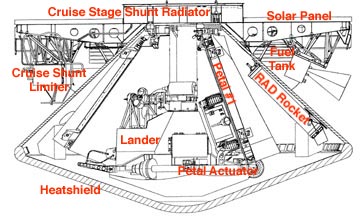![[Live from Earth and Mars]](../graphics/mars_map.gif)

![[Live from Earth and Mars]](../graphics/mars_map.gif)

 Three of the meteorology experiments temperature sensors are located
on the 1.1 meter tall mast, and, along with the wind sensor at the
top, and the pressure sensor, help characterize the atmospheric
surface layer. During cruise, they are inside the lander in the vacuum
of space and their temperature is governed by conduction to the
supports and thermal radiation from within the lander. Since the
temperature of the spacecraft varies due to solar heating, radiative
cooling to space and spacecraft thermal control, the sensors indicate
different temperatures. The configuration of the Atmospheric Structures/Meteorology
experiment and the factors most important to the temperatures are
described in this link and below.
Three of the meteorology experiments temperature sensors are located
on the 1.1 meter tall mast, and, along with the wind sensor at the
top, and the pressure sensor, help characterize the atmospheric
surface layer. During cruise, they are inside the lander in the vacuum
of space and their temperature is governed by conduction to the
supports and thermal radiation from within the lander. Since the
temperature of the spacecraft varies due to solar heating, radiative
cooling to space and spacecraft thermal control, the sensors indicate
different temperatures. The configuration of the Atmospheric Structures/Meteorology
experiment and the factors most important to the temperatures are
described in this link and below. The meteorology mast is 1.1 meters tall, located on the edge of one of the three petals of the lander, (Figure 6), and below. The mast base is located on the end of a lander petal, as far away as possible from the bulk of the lander, to minimize temperature and wind measurement errors due to flow distortion and heating of the atmosphere by the lander: we hope to compare these effects with those of Viking. The mast is seen at the bottom of the photograph, which also shows the solar cells. After the petals are folded, the bottom thermocouple ends up at the top of the lander, i.e., the peak of the tetrahedron.

The top of the mast image below, shows the thermocouple
temperature sensor, positioned to measure atmospheric
temperature during descent, the wind sensor, and the top of the other
three thermocouples. The wind sensor height is 1.1 meters, while the
temperature sensors are located 0.25, 0.5 and 1.0 meters above the
base of the mast. "Wind Socks", the small cone shaped objects, with
the counterweight on the other side of the pivot, are photographed by
the camera to estimate wind speed and direction. 
 The Base of the
lander sits in the entry Aero shell, immediately above its heat
shield. The heat shield is the brown cone at the bottom of this figure
and the cut away drawing. The Cruise stage is the ring above the
Entry/Lander vehicle, and the solar panels are on the top, out of
view. During Cruise, the solar panels point toward the sun, making
that end of the spacecraft the warmest, while the heat shield is
shaded by the solar array and views the cold of deep
space. Consequently, the lander is warmed by conduction from the
cruise stage, and cooled by radiative heat loss to space. The net
result is that the "bottom" thermocouple is physically, and thermally,
closest to the warmer cruise stage while the "top" thermocouple is
closest to the colder heat shield. Active thermal control also affects
the temperatures.
The Base of the
lander sits in the entry Aero shell, immediately above its heat
shield. The heat shield is the brown cone at the bottom of this figure
and the cut away drawing. The Cruise stage is the ring above the
Entry/Lander vehicle, and the solar panels are on the top, out of
view. During Cruise, the solar panels point toward the sun, making
that end of the spacecraft the warmest, while the heat shield is
shaded by the solar array and views the cold of deep
space. Consequently, the lander is warmed by conduction from the
cruise stage, and cooled by radiative heat loss to space. The net
result is that the "bottom" thermocouple is physically, and thermally,
closest to the warmer cruise stage while the "top" thermocouple is
closest to the colder heat shield. Active thermal control also affects
the temperatures.
Check here and in Resources for more details about Viking Meteorology and other measurements which will be added in the near future.
Thermocouples take advantage of the fact that if two different metals are joined, they produce a voltage proportional to the temperature. Different material combinations produce different output voltages with temperature, and are appropriate for different applications. The chromel -- constantan combination used for Pathfinder, and previously for Viking, produce an output voltage which changes by approximately 60 millionths of a volt for every 1 °C temperature change. Although small, this can be measured to an accuracy of 0.1 °C with good design and electronics. Future developments will include constructing simple thermocouple systems for accurate, fast temperature measurements and to investigate the errors encountered trying to measure air temperature.
